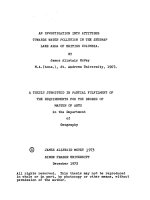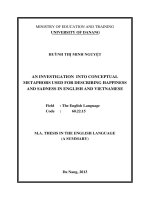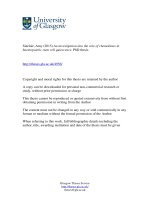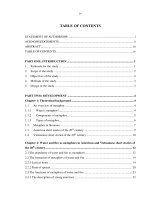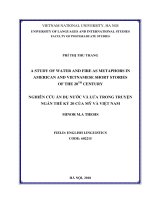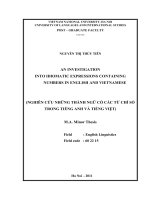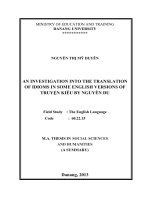An investigation into conceptual metaphors denoting “life” in american and vietnamese short stories from 1975 to 1991
Bạn đang xem bản rút gọn của tài liệu. Xem và tải ngay bản đầy đủ của tài liệu tại đây (1.29 MB, 110 trang )
VIETNAM NATIONAL UNIVERSITY, HANOI
UNIVERSITY OF LANGUAGES AND INTERNATIONAL STUDIES
FACULTY OF POST - GRADUATE STUDIES
*********************
ĐINH THỊ MAI ANH
AN INVESTIGATION INTO
CONCEPTUAL METAPHORS DENOTING “LIFE”
IN AMERICAN AND VIETNAMESE SHORT
STORIES
FROM 1975 TO 1991
NGHIÊN CỨU ẨN DỤ Ý NIỆM DÙNG ĐỂ BIỂU ĐẠT “CUỘC SỐNG”
TRONG CÁC TRUYỆN NGẮN CỦA MỸ - VIỆT TỪ 1975 ĐẾN 1991
M. A. Major Program Thesis
Field: English Linguistics
Code: 60220201
HA NOI - 2016
VIETNAM NATIONAL UNIVERSITY, HANOI
UNIVERSITY OF LANGUAGES AND INTERNATIONAL STUDIES
FACULTY OF POST - GRADUATE STUDIES
*********************
ĐINH THỊ MAI ANH
AN INVESTIGATION INTO
CONCEPTUAL METAPHORS DENOTING “LIFE”
IN AMERICAN AND VIETNAMESE SHORT
STORIES
FROM 1975 TO 1991
NGHIÊN CỨU ẨN DỤ Ý NIỆM DÙNG ĐỂ BIỂU ĐẠT “CUỘC SỐNG”
TRONG CÁC TRUYỆN NGẮN CỦA MỸ - VIỆT TỪ 1975 ĐẾN 1991
M. A. Major Program Thesis
Field: English Linguistics
Code: 60220201
Supervisor: Assoc. Prof. Dr. Ngô Đình Phương
HA NOI - 2016
DECLARATION
Except where reference is made in the text of the thesis, this thesis contains
no material published elsewhere or extracted in whole or in part from a thesis by
which I have qualified for or been awarded another degree or diploma.
No other person‘s work has been used without due acknowledgements in this
thesis.
This thesis has not been submitted for the award of any degree or diploma in
any other tertiary institutions.
Hanoi, 2016
Đinh Thị Mai Anh
i
ACKNOWLEDGEMENTS
First and foremost, the completion of this study could not have been possible
without the expertise of Assoc. Prof. Dr. Ngo Dinh Phuong, my beloved thesis
supervisor. I would like to express my sincere gratitude to him for his dedicated
guidance and constructive criticism extended to me.
My appreciation also goes to all the lecturers at Faculty of Post – Graduate
Studies, University of Languages and International Studies, who expertly guided me
through my education, shared their valuable knowledge and inspired me to carry out
this research.
Last but not least, I also place on record, my sense of gratitude to all the
family members for their unceasing support and great encouragement.
ii
ABSTRACT
Metaphor has attracted the attention of scholars interested in
language, especially rhetoricians and literary critics, for more than 2000 years.
Traditionally, metaphor was viewed as a matter of language, as a set of
extraordinary or figurative linguistic expressions only used in literature with the aim
to embellish discourse. However, cognitive linguistics presents a different view of
metaphor, stating that metaphor, in its broad sense, is pervasive and essential in
language and thought. It is defined as understanding one abstract conceptual domain
(target domain), in terms of another concrete conceptual domain (source domain).
The concept of life has been one of the most common target domains, which is hard
to fully comprehend without establishing a set of mappings, i.e. a set of systematic
correspondences, between this undelineated notion and other better-known one.
Therefore, this study attempts to probe into conceptual metaphors denoting life in
American and Vietnamese short stories from 1975 to 1991 from the perspective of
cognitive linguistics. Basing on a relatively considerable number of collected data,
the author makes an investigation into the similarities and differences in the use of
these conceptual metaphors in both languages, in the hope to contribute a part to the
process of foreign language teaching and learning, and translation practice.
iii
TABLE OF CONTENTS
DECLARATION ......................................................................................................... i
ACKNOWLEDGEMENTS ........................................................................................ ii
ABSTRACT .............................................................................................................. iii
TABLE OF CONTENTS ............................................................................................iv
LIST OF TABLES .................................................................................................... vii
CHAPTER 1. INTRODUCTION ..............................................................................9
1.1. Rationale of the study ........................................................................................... 9
1.2. Significance of the study .....................................................................................10
1.3. Aims and objectives ............................................................................................ 10
1.3.1. Aims of the study ............................................................................................. 10
1.3.2. Objectives of the study ..................................................................................... 11
1.4. Research questions ..............................................................................................11
1.5. Scope of the study ...............................................................................................11
1.6. Method and Procedures .......................................................................................12
1.6.1. Research Method .............................................................................................. 12
1.6.2. Data collection ................................................................................................. 13
1.6.3. Data analysis .................................................................................................... 13
1.7. Organization of the study ....................................................................................13
CHAPTER 2.THEORETICAL BACKGROUND AND LITERATURE
REVIEW .................................................................................................................. 15
2.1. Theoretical background ....................................................................................... 15
2.1.1. Cognitive Science ............................................................................................. 15
2.1.2. Cognitive Linguistics ....................................................................................... 15
2.1.3. Cognitive Semantics ......................................................................................... 17
2.1.4. Metaphor .......................................................................................................... 17
2.1.4.1. The traditional view of metaphors ................................................................. 17
2.1.4.2. Metaphors in the Cognitive Linguistic View.................................................. 20
2.1.5. Short stories ..................................................................................................... 28
2.2. Literature review ................................................................................................. 31
CHAPTER 3. RESEARCH METHODOLOGY .................................................... 34
3.1. Research design and methodology ....................................................................... 34
3.2. Data .................................................................................................................... 35
3.2.1. American short stories ...................................................................................... 35
3.2.2 Vietnamese short stories .................................................................................... 37
3.3. Data collection .................................................................................................... 38
iv
3.4. Data analysis ....................................................................................................... 40
3.5. Research procedures............................................................................................ 41
CHAPTER 4. FINDINGS AND DISCUSSIONS .................................................... 43
4.1. Quantitative analysis ........................................................................................... 43
4.1.1. Structural metaphors......................................................................................... 44
4.1.2. Ontological metaphors...................................................................................... 46
4.1.3. Orientational metaphors ................................................................................... 48
4.2. Qualitative analysis ............................................................................................. 49
4.2.1. Conceptual metaphors denoting life in American short stories .......................... 49
4.2.1.1. LIFE IS AN ENTITY .................................................................................... 49
4.2.1.2. LIFETIME IS PASSING OF TIME............................................................... 52
4.2.1.3. LIFE IS A JOURNEY ................................................................................... 54
4.2.1.4. LIFE IS A CONTAINER .............................................................................. 56
4.2.1.5. LIFE IS A PERSONAL POSSESSION ......................................................... 58
4.2.1.6. LIFE IS A PERSON ...................................................................................... 59
4.2.1.7. LIFE IS A MACHINE ................................................................................... 60
4.2.1.8. LIFE IS A WAR ............................................................................................ 61
4.2.1.9. LIFE IS A STORY ........................................................................................ 62
4.2.1.10. LIFE IS A GAME ....................................................................................... 63
4.2.1.11. LIFE IS A PAIN .......................................................................................... 63
4.2.2. Conceptual metaphors denoting life in Vietnamese short stories ....................... 63
4.2.2.1. LIFE IS AN ENTITY .................................................................................... 63
4.2.2.2. LIFETIME IS PASSING OF TIME............................................................... 66
4.2.2.3. LIFE IS A JOURNEY ................................................................................... 67
4.2.2.4. LIFE IS A CONTAINER .............................................................................. 69
4.2.2.5. LIFE IS A PERSONAL POSSESSION ......................................................... 70
4.2.2.6. LIFE IS A PERSON ...................................................................................... 71
4.2.2.7. LIFE IS A MACHINE ................................................................................... 71
4.2.2.8. LIFE IS A WAR ............................................................................................ 71
4.2.2.9. LIFE IS A STORY ........................................................................................ 71
4.2.2.10. LIFE IS A GAME ....................................................................................... 72
4.2.2.11. LIFE IS A PAIN .......................................................................................... 73
4.3. Research findings ................................................................................................ 73
4.3.1. Similarities ....................................................................................................... 73
4.3.2. Differences ....................................................................................................... 77
CHAPTER 5. CONCLUSION AND IMPLICATIONS ......................................... 80
5.1. Conclusion .......................................................................................................... 80
5.2. Implications for the study .................................................................................... 80
5.2.1. Implications for teachers .................................................................................. 80
v
5.2.2. Implications for learners ................................................................................... 81
5.2.3. Implications for translators ............................................................................... 82
5.3. Limitations and suggestions for further studies .................................................... 83
REFERENCES
APPENDIX A. AMERICAN CORPUS ANALYZED IN THE STUDY
APPENDIX B. VIETNAMESE CORPUS ANALYZED IN THE STUDY
vi
LIST OF TABLES
Number of
Name of Tables
Tables
Page
1.1.
American & Vietnamese short stories from 1975 - 1991
4
2.1.
Metaphorical Mapping between Conceptual Domains
15
2.2.
Metaphorical Mapping between Conceptual Domains
15
2.3.
Metaphorical Mapping between Conceptual Domains
18
2.4.
Orientational Metaphors
19
3.1.
American corpus analyzed in the study
30
3.2.
Vietnamese corpus analyzed in the study
31
4.1.
Conceptual Metaphors denoting life
34
Occurrence and Percentage of Conceptual Metaphors
4.2.
denoting life in American and Vietnamese short stories
35
from 1975 to 1991
Occurrence and Percentage of Structural Metaphors
4.3.
denoting life in American and Vietnamese short stories
36
from 1975 to 1991
Occurrence and Percentage of Ontological Metaphors
4.4.
denoting life in American and Vietnamese short stories
37
from 1975 to 1991
Occurrence and Percentage of Orientational metaphors
4.5.
denoting life in American and Vietnamese short stories
from 1975 to 1991
vii
39
viii
CHAPTER 1
INTRODUCTION
1.1. Rationale of the study
Cognitive linguistics is the approach to the study of language that began to
emerge in the 1970s and has been increasingly active since the 1980s. Until now, a
large amount of research has been carried out in the light of cognitive linguistics
over the world in general and in Vietnam in particular, and most of them have
focused on semantics with a deeper insight into the use of conceptual metaphor in
language. Conceptual metaphors involve two concepts and have the form A is B,
where the more abstract concept A such as love, life, economy and argument is
comprehended in terms of the more concrete concept B including war or a
container. Therefore, the investigation into conceptual metaphors with the aim to
find out similarities and differences of using this kind of meaning transference
among languages in the world brings great benefits to the English teaching, learning
and translating process.
Life has been one of the most inspirational and enchanting topics for
thousands of writers across the time. Although the concept of life is commonly
mentioned in our daily life or everyday conversations, its definition or true meaning
cannot be described by only one or two words. Life is the mixture of everything –
the mixture of happiness and sadness, success and failure, comfort and pain,
encouragement and frustration, opportunities and obstacles, love and hatred, relief
and sorrow, and struggle and surrender. Therefore, it is hard to fully comprehend
the concept of life itself without any connection with other concrete notions or
tangible objects. To illustrate that, imagine life is a game. People are considered as
players, who need to play as skillfully and fairly as they can with the aim to win, or
acquire their own goals in life. If the concept of life is perceived in terms of a
journey, people are considered as travellers trying their best to overcome all
impediments on their way to reach the final destinations. As a result, the abstract
concept of life can be metaphorically mentioned through other more delineated
ones. Depending on the distinctive features of different cultures or specific
geographical characteristics of regions in the world, life has its own uniqueness.
9
The conceptualization of life in American and Vietnamese short stories and
the universal and unique conceptual metaphors referring to life among languages
have given me a great inspiration to carry out a research entitled: ―An investigation
into conceptual metaphors denoting “life” in American and Vietnamese short
stories from 1975 to 1991‖. Hopefully, the findings of this study would make a
contribution to the process of understanding and interpretation of conceptual
metaphors in American and Vietnamese short stories.
1.2. Significance of the study
This research is carried out in the hope to contribute a small part to the
consolidation of cognitive linguistic theory in general, and cognitive semantics in
particular. Although there are a number of investigations into conceptual metaphors
in the world and in Vietnam as well, how the concept of life is conceptualized in
short stories, and how metaphorical expressions used to denote this abstract notion
are similar and different among languages, have not been examined yet. Therefore,
this study is expected to help learners who have not exposured much in life and
might find it difficult to understand this concept when reading materials or having a
conversation with foreign people. Moreover, it is hoped to contribute to the process
of teaching and learning American literature in foreign languages departments or
universities in Vietnam, and of translating American shorts stories or other forms of
art into Vietnamese and vice verse.
1.3. Aims and objectives
1.3.1. Aims of the study
This research aims to:
-
Carry out an investigation into conceptual metaphors denoting life in some
American and Vietnamese short stories based on the theory of cognitive
semantics.
-
Make a comparison of using conceptual metaphors to express life in
American versus Vietnamese short stories.
-
Make contributions to learning, teaching and translating process.
10
1.3.2. Objectives of the study
To gain the aims above, the researcher attempts to:
-
Identify the conceptual metaphors of life in some American and Vietnamese
short stories in terms of cognitive linguistics.
-
Categorize these conceptual metaphors in the frame of linguistic cognitivism.
-
Analyze and discover the similarities and differences in the conceptual
metaphors denoting the concept of life in some American and Vietnamese
short stories.
-
Make some suggestions for foreign language teaching and learning, as well
as for translating process.
1.4. Research questions
In order to achieve the aims and objectives of the investigation, the
researcher attempts to give answers to the following questions:
a. How are the conceptual metaphors of life conceptualized in American and
Vietnamese short stories from 1975 to 1991?
b. What are the similarities and differences of the conceptual metaphors
denoting life in American and Vietnamese short stories from 1975 to 1991?
c. What are the implications for the use of conceptual metaphors in teaching,
learning and translating?
1.5. Scope of the study
The study merely focuses on investigating the conceptual metaphors
denoting life based on the theory of cognitive linguistics. The researcher also
chooses to investigate these conceptual metaphors in nineteen American short
stories and nineteen Vietnamese short stories from 1975 to 1991, as follows:
No.
1.
2.
American short stories
A silver dish (Saul Bellow, 1979)
Gesturing (John Updike, 1980)
Vietnamese short stories
Vệ sỹ của Quan Châu (Ma Văn
Kháng,1978)
Hai ông già ở Đồng Tháp Mười (Nguyễn
Khải, 1981)
11
3.
4.
5.
6.
7.
8.
9.
10.
11.
12.
13.
14.
15.
16.
17.
18.
19.
Where I‘m calling from (Raymond
Carver, 1983)
Janus (Ann Beattie, 1986)
The way we live now (Susan
Sontag, 1987)
Menseteung (Alice Munro, 1989)
Người gặp hằng ngày (Nguyễn Khải,
1981)
Chuyến bay (Nguyễn Minh Châu, 1983)
Gió từ miền cát (Xuân Thiều, 1983)
Khách ở quê ra (Nguyễn Minh Châu,
1984)
You‘re ugly, too (Lorrie Moore, Tháng ngày đã qua (Xuân Thiều, 1984)
1990)
The legend of pig - eye (Rick Bass, Người mẹ tội lỗi (Xuân Thiều, 19841990)
1985)
The trip back (Robert Olen Butler, Bến quê (Nguyễn Minh Châu, 1985)
1990)
The point (Charles D‘Ambrosio, Thành phố thấp thoáng (Xuân Thiều
JR, 1990)
1986-1987)
Oil and water (Millicent Dillion, Chiếc thuyền ngoài xa (Nguyễn Minh
1990)
Châu, 1987)
The body shop (Elizabeth Graver, Trung du chiều mưa buồn (Ma Văn
1990)
Kháng, 1987)
Houdini (Siri Hustvedt, 1990)
Phiên chợ Giát (Nguyễn Minh Châu,
1989)
Bologoye (Mikhail Lossel, 1990)
Nắng chiều (Nguyễn Khải, 1989)
Glossolalia (David Jauss, 1990)
Đổi đời (Nguyễn Khải, 1990)
Viva la Tropicana (Leonard
Ông trưởng họ (Nguyễn Khải, 1991)
Michaels, 1990)
Willing (Lorie Moore, 1990)
Heo may, gió lộng (Ma Văn Kháng, 1991)
Friend of my youth (Alice Munro, Móng vuốt thời gian (Ma Văn Kháng,
1990)
1991)
American, Abroad (Joyce Carol Một thời gió bụi (Nguyễn Khải, 1991)
Oates, 1990)
Table 1.1: American & Vietnamese short stories from 1975 - 1991
1.6. Method and Procedures
1.6.1. Research Methods
In this study, the quantitative and quanlitative methods are applied in order to
achieve its aims and objectives. In addition, this research is also carried out on the
base of contrastive and comparative analysis so as to make an investigation into the
12
similarities and differences in metaphorical expressions manifested in conceptual
metaphors denoting life in American and Vietnamese short stories from 1975 to
1991 from cognitive semantic approach.
1.6.2. Data collection
Metaphorical expressions denoting life are collected from American and
Vietnamese short stories composed during the time from 1975 to 1991, and
published in printed editions.
Nineteen American short stories are taken from two famous collections of
short stories including The Best American Short Stories of the Century edited by
John Updike and Katrina Kenison (1999), and The Best American Short Stories
1991 selected from U.S Magazines by Alice Adams and Katrina Kenison (1991).
Nineteen Vietnamese short stories written by well-known authors those days
are collected from collections of short stories including Nguyễn Khải truyện ngắn 1
selected by Nguyễn Phan Hách and Nguyễn Khắc Trường (2003), Truyện ngắn
Nguyễn Minh Châu, tác phẩm và lời bình by Tuấn Thành and Vũ Nguyễn (2007),
Truyện ngắn Ma Văn Kháng by Trung Trung Đỉnh and Nguyễn Khắc Trường
(2008), and Xuân Thiều toàn tập, tập 3 by Ngô Vĩnh Bình (2015).
1.6.3. Data analysis
In order to achieve the aims of this study, the data are both quantitatively and
qualitatively analyzed. Firstly, the data is quatitatively examined in terms of
occurence of three types of conceptual metaphors classified by Lakoff and Johnson
(1980), specifically structural metaphors, ontological metaphors, and orientational
metaphors. Secondly, the two sets of data will be qualitatively analyzed and
compared in order to find out the similarities and differences between conceptual
metaphors denoting life in some American and Vietnamese short stories from 1975
to 1991.
1.7. Organization of the study
The thesis consists of three main parts:
13
Chaper 1 ―Introduction” will include the rationale, the aims and objectives
of the study, the significance, the research questions, the scope and the organization
of the study.
Chapter 2 includes the “Theoretical Background and Literature Review”
where a review of previous studies is carried out and the theoretical background is
provided.
Chapter 3 is about the “Research Methodology” of the study. This chapter
will mention the methodology, the design of the research, the ways of data
collection, data analysis.
Chapter 4 gives the “Findings and Discussions” related to the conceptual
metaphors denoting LIFE in some American and Vietnamese short stories.
Chapter 5 entitles “Conclusions and Implications”. This chapter will sum
up the development of the study, provide implications for teaching, learning and
translating cognitive metaphors in English and Vietnamese. It will also present
some limitations and suggestions for further research.
14
CHAPTER 2
THEORETICAL BACKGROUND AND LITERATURE REVIEW
2.1. Theoretical background
2.1.1. Cognitive Science
The term “Cognition”, as used by cognitive scientists, derives from the Latin
root (cognosco, cognoscere, cognovi, congnitum, which means to know, to
conceptualize or to recognize) and is defined in the Oxford Advanced Learner’s
Dictionary (Hornby, 2000) as ―the process by which knowledge and understaning is
developed in the mind‖ (p. 299). It encompasses mental processes such as attention,
memory, production of language, problem solving and decision making. Ly Toan
Thang (2005) considered “Cognition” as the process of absorbing, storing and
processing information into knowledge (p. 16).
Cognitive science, which has attracted significant attention since the late 20th
century, is the interdisciplinary investigation of the mind and intelligence. In
contrast with some early philosophical theories and commonsense views treating
the mind as souls and spirits, not suitable for scientific study, Cognitive science
consider it to be a valuable source of data in order to investigate the mind and
understand how information is processed in human‘s brains on the base of the ideas
and methods of psychology, linguistics, philosophy, computer science, artificial
intelligence, neuroscience and anthropology. For instance, linguists collect evidence
about the way people produce and understand meaningful sentences. Meanwhile,
psychologists will gather behavioral evidence relating to social interaction,
language comprehension and emotional experience. Until now, the cooperation of
scientists from different fields in attempts to understand the mind has brought
illuminating explanations of many kinds of human thinking.
2.1.2. Cognitive Linguistics
Cognitive Linguistics is an approach to the analysis of natural language that
originated in the late 1970s and early 1980s in the work of George Lakoff, Ron
Langacker, and Len Talmy. In contrast with other linguistic researches, Cognitive
15
Linguistics is deemed to be a flexible framework rather than a single theory of
language. In other words, it includes a cluster of many partially overlapping
approaches rather than a single well-defined theory. In the light of Cognitive
Linguistics, language is considered as a way of organizing knowledge that reflects
the needs, interests, and experiences of individuals and cultures. The formal
structures of language are studied not as if they were autonomous, but as reflections
of
general
conceptual
organization,
categorization
principles,
processing
mechanisms, and experiential and environmental influences (Geeraerts &
Cuyckens, 2007). Whereas the generative grammarians only analyze language on
the base of a precisely formulated set of rules whose output is all the grammatical
sentences in a given language, for the Cognitive approach, natural language is not
only seen as a system of rules, but also a repository of world knowledge, a
structured collection of meaningful categories that help us deal with new
experiences and store old information (Geeraerts & Cuyckens, 2007).
Until now, its theory formation is not yet completely stabilized. However,
according to Croft & Cruse (2004), there are three fundamental hypotheses
considered as the guiding principles of Cognitive Linguistics to language:
- Language is not an autonomous cognitive faculty.
- Grammar is conceptualization.
- Knowledge of language emerges from language use.
These above hypotheses are presented as opposite responses to the other vigorous
research paradigms including Generative Grammar and Truth-conditional
Semantics. Today, the arguments and empirical questions are still raised by the
cognitive linguistics to protect their hypotheses.
Topics of special interest for Cognitive Linguistics include: the structural
characteristics of natural language categorization (such as prototypicality,
systematic polysemy, cognitive models, mental imagery, and metaphor); the
functional principles of linguistic organization (such as iconicity and naturalness);
the conceptual interface between syntax and semantics (as explored by Cognitive
Grammar and Construction Grammar); the experiential and pragmatic background
16
of language-in-use; and the relationship between language and thought, including
questions about relativism and conceptual universals.
Although there has been more than thirty years of development in the world,
researches related to “Cognitive linguistics” just account for an insignificant
numbers in Viet Nam with some noticeable authors such as Lý Toàn Thắng (2005),
Trần Văn Cơ (2007), Phan Văn Hoà (2008), Nguyễn Đức Tồn (2007, 2008) and
Nguyễn Lai (2009).
2.1.3. Cognitive Semantics
Cognitive semantics, which is similar to the larger enterprise of cognitive
linguistics, is not a unified theory. It represents an approach to the study of mind
and its relationship with embodied experience and culture. It proceeds by
employing language as a key methodological tool for uncovering conceptual
organization and structure. It began in the 1970s as a reaction against the objectivist
world-view assumed by the Anglo-American tradition in philosophy and the related
approach, truth-conditional semantics, developed within formal linguistics. While
―by viewing meaning as the relationship between words and the world, truthconditional semantics eliminates cognitive organization from the linguistic system‖
(Sweetser, 1990, p.4), cognitive semantics sees linguistic meaning as a
manifestation of conceptual structure. ―Research on cognitive semantics is research
on conceptual content and its organization in language‖ (Talmy, 2004, p.4).
Evans and Green (2006) in their book Cognitive Linguistics: An Introduction
examine the four guiding principles that collectively characterize the collection of
approaches that fall within semantics, as follows:
1. Conceptual structure is embodied.
2. Semantic structure is conceptual structure.
3. Meaning representation is encyclopedic.
4. Meaning-construction is conceptualization.
2.1.4. Metaphor
2.1.4.1. The traditional view of metaphors
17
The possibility of differentiating between literal and figurative language has
been always drawing attention of Western linguistic scholars since at least the time
of Aristotle. Within that general process, researchers have concentrated on
introducing a system on the base of this differentiation and discussing further
distinctive features among different types of meaning transference. These figurative
devices including metaphor, metonymy, hyperbole, litotes, irony and euphemisms
have been used in literature with the aim to embellish discourse, to paint a vivid
picture, or in other words, to convey a thought more forcefully than a plain
statement. Within those discussions, the different valuations of the figurative, or
more specifically, views of metaphors as ornaments have been a controversial issue
for years.
Let us begin with Aristotle, who is considered as the father of metaphor
theory. He supposed that ―It is the one thing that cannot be learnt from others, and it
is also a sign of genius, since a good metaphor implies an intuitive perception of the
similarity in dissimilar‖ (Aristotle, 1909, p.71). In other words, metaphor was
considered as a conscious and deliberate use of words, and only great poets and
eloquent speakers, who must have special talent such as Shakespeare and Churchill,
could be its masters. In particular, Aristotle limited the use of metaphor merely in
poetry and regarded it as a kind of decoration or ornament. As a result, metaphor in
the traditional view was not an inevitable part of everyday human communication,
merely in literature.
Metaphor was defined as ―giving the thing a name that belongs to species, or
from species to genus, or from species to species, on grounds of analogy‖ (Aristotle,
1909, p.63). In other words, everything in nature has its own ‗proper name‘;
however, metaphor infringes this rule by using the name of one thing to convey the
other. In literature, simile has been also used with the same purpose. However, the
significant difference is that metaphor is considered to be implicit comparison and
have no elements of comparison, whereas simile is explicit one with the use of
signaling words such as ―like‖, or ―as‖. It is said that the omission of the ―like‖ in
metaphor brings two compared entities far closer to each other, which challenges
readers to understand the comparison, deepens their experience and helps them to
18
gain some additional understanding from the analogies presented. In general, using
metaphor has much greater power than simile.
Kövecses (2010) points out that in the traditional view, similarity is
considered as the basis of metaphor; in other words, one linguistic expression rather
than another is chosen to speak metaphorically about something on the base of
resemblances. Thus, the excessive production of metaphor has been limited because
of this similarity constraint. He takes ―the roses on her cheeks‖ as a typical example
presenting noticeable features of traditional view of metaphor. Firstly, metaphor is
deemed to be language‘s decorations or ornaments. In this example, ―roses‖ are
used to describe the blushing cheeks on someone‘s face. The main purpose of this
metaphor is to enhance readers‘ feeling, not to use the word ―roses‖ as part of the
process of conceptualizing and understanding one thing in terms of another.
Secondly, metaphor in the traditional view is a linguistic phenomenon, instead of a
conceptual one. To be more specific, metaphor means only using one word, phrase
or expression in order to refer to others, rather than one conceptual domain to
perceive another. Thirdly, the reason for choosing ―roses‖ to talk about somebody‘s
cheeks is because of the similar color between this kind of flower and women‘s
cheeks (pink or red), which exists in human‘s life even before people use this
metaphor. Finally, in the traditional view, certain preexisting similarities can limit
the selection of linguistic expression used metaphorically in place of others to
describe the world. Therefore, in order to describe the pinkish color on someone‘s
face, it is unusual to use the word ―sky”, as in ―the sky on her cheeks”, because
there is no resemblance between the blue color of the sky and the pinkish color on a
person‘s cheeks. To sum up, the choice of metaphorical expressions in both
conventional and unconventional language use depends on the preexisting similarity
in reality. However, there are a huge number of other metaphorical expressions in
life, which can be used without any preexisting similar points, such as between
―digesting foods” and “digesting ideas”, or “We’re not going anywhere,” and
“This relationship is not going anywhere.”
In order to seek for the answer of these linguistic phenomena, cognitive
linguistics have done thousands of research with the aim to provide an account of
19
the selection of metaphorical source concepts and their corresponding metaphorical
linguistic expressions.
2.1.4.2. Metaphors in the Cognitive Linguistic View
A new view of metaphor that challenged all the aspects of the powerful
traditional theory in a systematic way was first developed by George Lakoff and
Mark Johnson in 1980 in their seminal study: Metaphor We Live By. Lakoff and
Johnson in their work strongly stated that:
1) Metaphor is a property of concepts, not of words.
2) The purpose of using metaphor is to comprehend concepts in a deeper way,
not just for decorative function in literature.
3) The basis of metaphor is not merely based on similarity.
4) Metaphor is not a matter of special talents, but is used effortlessly in
everyday life by ordinary people
5) Metaphor is not a superfluous process by using metaphorical expressions,
but is an integral one of human thought and reasoning in order to conceive
the world.
2.1.4.2.1. What is metaphor?
In the cognitive linguistic view, metaphor is defined as understanding one
conceptual domain in terms of another conceptual domain. In other words, it can be
understood that ―CONCEPTUAL DOMAIN A‖ IS ―CONCEPTUAL DOMAIN B‖,
which is called a conceptual metaphor. To be more specific, in each conceptual
metaphor, there are two conceptual domains, in which one domain is understood in
terms of another. A conceptual domain is any coherent organization of experience.
Let us take a paragraph that contains metaphorical linguistic expressions to talk
about life, used pervasively in reality by native speakers of English, as an excellent
example.
People might say that they try to give their children an education so they
will get a good start in life. If their children act out, they hope that they are
just going through a stage and that they will get over it. Parents hope that their
children won‘t be burdened with financial worries or ill health and, if they
20
face such difficulties, that they will be able to overcome them. Parents hope
that their children will have a long life span and that they will go far in life.
But they also know that their children, as all mortals, will reach the end of the
road.
(Winter, 1995, p. 235)
In this example, life is considered as a journey. Therefore, we have a
conceptual metaphor: LIFE IS A JOURNEY, in which life is conceptual domain A,
and a journey is conceptual domain B. People use the expressions of a journey in
order to comprehend the elusive concept of life. More specifically, in a journey,
travelers are the ones who carry out the action of travelling. They get their start,
their way and their destination. Additionally, they need means of transports to help
them quickly reach their final point. Obviously, there are no journeys full of
happiness and luck, and the travelers have to overcome obstacles in order to finish
their journeys. By such understanding, people in their life are also travellers.
Everybody also wants to ―get a good start‖ in life; however, life always consists of
impediments and difficulties, which demands people to make strong efforts with the
aim to ―go through a stage‖, overcome all the daily burdens, ―have a long life
span‖, and ―go far in life‖.
Linguistic researchers also find out other huge number of examples, in which
English speakers make extensive use of the more concrete domain of journey to
refer to the highly abstract concept of life.
He‘s without direction in life.
I‘m where I want to be in life.
I‘m at a crossroad in my life.
For additional examples, we also can talk and think about theories in terms of
buildings, arguments in terms of war, ideas in terms of food, social organizations in
terms of plants and so on.
Therefore, it is necessary to point out the distinctive features between
conceptual metaphor and metaphorical expressions. Lakoff (1992) suppose that the
word metaphor has come to mean a cross-domain mapping in the conceptual
21
system. Thus, the term metaphorical expressions “refer to a linguistic expression (a
word, phrase, or sentence) that is the surface realization of such a cross-domain
mapping (this is what the word metaphor referred to in the old theory)‖ (Lakoff,
1992, p.1). In other words, the words or other linguistic expressions commonly
appear in the use of describing CONCEPTUAL DOMAIN B and are used to
metaphorically talk about CONCEPTUAL DOMAIN A, which are called
metaphorical expressions. To illustrate that, we have a conceptual metaphor LIFE
IS A JOURNEY, and the linguistic metaphorical expressions manifested from this
metaphor may include ―without direction‖, ―at a crossroad‖, ―go places in life‖,
―get in his way‖, and ―go through a lot in life‖. As a result, the nature of the
relationship between conceptual metaphors and the metaphorical linguistic
expressions can be that the linguistic expressions (i.e., ways of talking) make
explicit, or are manifestations of, the conceptual metaphors (i.e., ways of thinking).
The two domains of a conceptual metaphor also have distinctive names.
―The conceptual domain for which we draw metaphorical expressions to understand
another conceptual domain is called source domain, while the conceptual domain
that is understood this way is the target domain” (Kövecses, 2010, p.4). The target
domain is the domain that we try to comprehend through the use of the source
domain. Therefore, ―conceptual metaphors typically employ a more abstract
concept as target and a more concrete or physical concept as their resource‖
(Kövecses, 2010, p.7). In studying the most frequent source domains, Kövecses
(2010) pointed out that the most systematic comprehensive survey is provided by
Alive Deignan‘s Collins Cobuild English Guides 7: Metaphor. To be more specific,
some common source domains are the human body (including the head, face, legs,
hands, back, heart, bones, shoulders, and others), health and illness, animals, plants,
buildings and construction, machines and tools, games and sport, money and
economic transactions, cooking and food, heat and cold, light and darkness, forces,
and movement and direction. Kövecses (2010) also presented some common target
domains such as emotion (anger, fear, love, happiness, sadness, shame, pride, and
so on), desire, morality, thought, society/nation, politics, economy, human
relationships, communication, time, life and death, religion, and events and actions.
22
2.1.4.2.2. Conceptual Metaphor as a Set of Mappings
The definition of metaphor in the light of cognitive linguistics is
CONCEPTUAL DOMAIN A is understood in terms of CONCEPTUAL DOMAIN
B. To be more specific, ―there is a set of systematic correspondences between the
source and the target in the sense that constituent conceptual elements of B
correspond to constituent elements of A‖ (Kövecses, 2010, p.7). These conceptual
correspondences are commonly regarded as mappings. Let us take the SOCIAL
ORGANIZATIONS ARE PLANTS conceptual metaphor as an example.
SOCIAL ORGANIZATIONS ARE PLANTS
He works for the local branch of the bank.
Our company is growing.
They had to prune the workforce.
A set of correspondences, or mappings between constituent elements of the
source (i.e. PLANTS) and those of the target (i.e. SOCIAL ORGANATIONS) can
be laid out as follows.
Source: PLANT
Target: SOCIAL ORGANIZATION
(1) the whole plant
the entire organization
(2) a part of the plant
a part of the organization
(3) growth of the plant
development of the organization
(4) removing a part of the plant
reducing the organization
(5) the root of the plant
the origin of the organization
(6) the flowering
the best stage, the most successful stage
(7) the fruits
the beneficial consequences
Table 2.1 Metaphorical Mapping between Conceptual Domains
Let us consider another example with the conceptual metaphor LOVE IS A
JOURNEY, in which the target domain - love is conceived in terms of the source
domain – a journey. Some metaphorical linguistic expressions are commonly used
23



